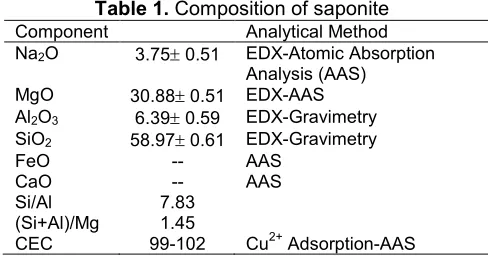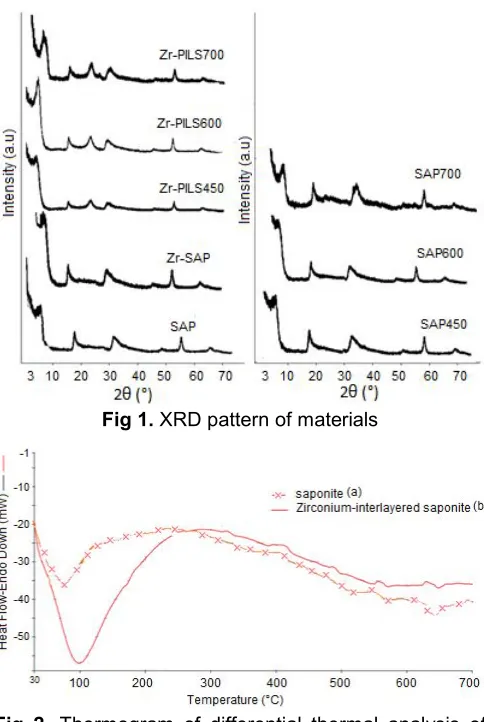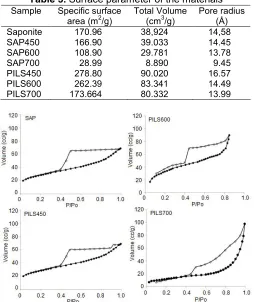Effect of Calcination Temperature on the Synthesis of ZrO
2-Pillared Saponite
to Catalytic Activity in Menthol Esterification
Is Fatimah
*, Dwiarso Rubiyanto, and Nanda Candra Kartika
Department of Chemistry, Islamic University of Indonesia Jl. Kaliurang KM 14.5 Sleman Yogyakarta 55584 Indonesia
Received June 30, 2015; Accepted October 8, 2015
ABSTRACT
The influence of calcination temperature on the synthesis of zirconia-pillared saponite (PILS) and on its catalytic activity in menthol esterification has been studied. Zirconia pillarization was conducted using zirconium tetraisopropoxide as a precursor and with calcination temperatures of 450, 600 and 700 °C. Evaluation of physicochemical characteristics at these varied temperatures was carried out by X-Ray Diffraction (XRD), surface area analysis, Scanning Electron Eicroscope (SEM) analysis, Differential Thermal Analysis (DTA) and total acidity. The obtained results indicate that the structure and surface acidity of saponite were strongly influenced by calcination temperature. The solid acidity and surface parameters such as specific surface area, pore volume, and pore radius play an important role in the total conversion and selectivity in menthol esterification.
Keywords:clay; saponite; pillarization; ZrO2; esterification
ABSTRAK
Kajian pengaruh temperatur kalsinasi pada sintesis saponit terpilar zirconia (PILS) dan aktivitas katalitiknya pada esterifikasi mentol telah dilakukan. Pilarisasi zirconia dilakukan menggunakan precursor zirconium tetraisopropoksida dengan variasi temperatur kalsinasi 450, 600 dan 700 °C. Evaluasi karate fisikokimiawi material dilakukan menggunakan instrumen difraksi sinar X (XRD), analisis luas permukaan, analisis scanning electron microscope (SEM) dan Differential Thermal Analysis (DTA) serta total keasaman padatan. Hasil penelitian menunjukkan adanya pengaruh kuat dari temperatur kalsinasi terhadap struktur dan parameter permukaan seperti luas permukaan, volume pori dan jejari pori serta berpengaruh terhadap konversi total dan selektivitas pada esterifikasi mentol.
Kata Kunci:lempung; saponit; pilarisasi; ZrO2; esterifikasi
INTRODUCTION
Synthesis of organic compounds using a heterogeneous catalyst is a recent trend in terms of green chemistry. Some important reactions that are usually conducted by using a homogeneous acid catalyst are replaced by utilization of a solid acid catalyst. Among several inorganic materials utilized as catalyst support, clays are widely used because they are easily modified, have high specific surface area, and are low cost. Several investigations have reported successful on the modification of clay materials and on their catalytic activity in a variety of chemical reactions [1].
Smectite clay, particularly smectite material is one of minerals for some organic reactions. Smectite itself is group of clay minerals with the Si/Al ratio of 2:1 and has an interlayer structure. Most of the works on smectite modification as a catalyst concern the utilizations and manipulations of its surface acidity consist of Brønsted
or Lewis acid sites. Metal oxide modifications are efforted to enhance the surface acidity, which has a direct effect on improving catalytic performance in such acid catalyzed reactions. One interesting modification is the dispersion of metal oxide catalyst pillarization into the smectite structure. Several metal oxides such as ZrO2, TiO2, ZnO are reported.
Clay pillarization by using ZrO2has been reported
selectivity of the solid catalyzed condition is important. Refer to the feasibility of ZrO2modified smectite catalyst,
this research deals with the use of ZrO2-saponite as a
catalyst in menthol esterification. Zirconia itself can act as an acid catalyst for several other esterification reactions, as reported by previous investigations [9-10]. As in other forms of metal oxide pillarization, calcination temperature strongly affects the physicochemical character including the solid acidity profile; therefore, the effect of calcination temperature on solid acidity and catalytic activity is studied [1,11-12].
The aims of this investigation are to study the effect of temperature on some physicochemical characteristics such as surface acidity, specific surface area and pore distribution, and also to study the relationship between these effects on catalytic activity in menthol esterification. Preparation of zirconium-pillared saponite was conducted using the sol-gel method using zirconium isopropoxide as a precursor. The advantage of using this precursor is the minimal acid effect obtained by the utilization of other precursors such as ZrOCl2.
EXPERIMENTAL SECTION
Materials
Saponite (SAP) was obtained from Kuninime Industrial Co. Japan and was used without any further purification. Zirconium isopropoxide, isopropanol, menthol were purchased from Sigma-Aldrich, and anhydrous acetic acid was obtained from Merck. The chemical composition of saponite and also the cation exchange capacity (CEC) with the analytical method are listed in Table 1.
Instrumentation
For material characterization purposes, some instruments were used consist of Shimadzu X6000 X-ray diffraction instrument, gas sorption analyzer of Micromeritics ASAP 2000 instrument, scanning electron microscopy (SEM) Seiko microscope and also differential thermal analysis of SEIKO instrument.
Procedure
Synthesis of ZrO2-pillared saponite
Pillarization consisted of two main steps; the intercalation reaction and calcination. Intercalation was performed by preparing zirconium precursor by diluting zirconium isopropoxide in 2-propanol followed by stirring for 4 h before dispersal into a saponite suspension in double distilled water with a concentration of 5 wt.%. The theoretical content of Zr to saponite was fixed at 6 wt.%. Zirconium precursor solution was added droply into the
Table 1.Composition of saponite Component Analytical Method Na2O 3.750.51 EDX-Atomic Absorption
Analysis (AAS) MgO 30.880.51 EDX-AAS Al2O3 6.390.59 EDX-Gravimetry
SiO2 58.970.61 EDX-Gravimetry
FeO -- AAS
CaO -- AAS
Si/Al 7.83
(Si+Al)/Mg 1.45
CEC 99-102 Cu2+Adsorption-AAS
suspension of 10 g saponite in 2 L water (5% w/v). The mixture of zirconium precursor and clay suspension was refluxed for 6 h. From the mixture, the solvent was evaporated and the obtained solid, called intercalated saponite (Zr-SAP), was heated in an oven overnight at 70 °C. Calcination at temperatures of 450, 500 and 700 °C was performed to produce zirconium-pillared saponite, and from the various temperature samples designated as PILS450, PILS600, and PILS700 were produced respectively. As a reference, raw saponite without zirconium intercalation was also calcined at the same varied temperatures, and the resulting solids were encoded as SAP450, SAP600, and SAP700.
Characterization
The obtained solid products were characterized by X-ray diffraction using Cu K radiation (40 kV,
50 mA) in the 2range between 2-80°. For the surface profile parameters, the N2 adsorption isotherms were
obtained using gas sorption analyzer. The samples were degassed at 90 °C for 6 h before the measurement. The Brunauer-Emmett-Teller (BET) method was used for Specific surface area (SBET)
estimation, and thee Baret-Joyner-Halenda (BJH) method was used for pore radius and pore distribution determination. Scanning electron microscopy (SEM) micrographs were obtained using Seiko microscope operated at 30 kV. Differential thermal analysis was measured by using a SEIKO instrument.
A total acidity test of the samples was carried out using the back titration method based on acid-base titration. The solid sample was suspended in an n-butylamine solution in excess amount and stirred overnight in order to make sure that all acid sites of the solid had been in contact with n-butylamine as a base. The unreacted n-butylamine was then determined by titration using citric acid as standard, Total acidity was reported as meq n-butylamine per weight of solid.
Catalytic activity test
analysis, 0.2 g of catalyst was added to the mixture in a flask consisting of 1 mole of menthol, 1 mole of anhydrous acetic acid and 10 mL of n-hexane. The reaction was conducted for 6 h. The liquid product was collected by filtering the mixture and analysis of the liquid was performed by gas chromatography (GC). The total conversion and selectivity of the catalysts were calculated based on GC analysis, using the following formula:
With [menthol], [menthyl acetate] and [isomenthone] are the concentration of menthol, menthyl acetate and isomenthone respectively.
RESULT AND DISCUSSION
Fig. 1 depicts X-ray diffraction patterns of materials. From the diffractograms it can be seen that all samples show the pattern of a saponite structure as indicated by the reflections at d = 14-16 Å (001), 4-6 Å (002) and at around 2.5-2.8 Å (006). The (001) reflections of Zr-SAP and all PILS samples show that there is a shift of (001) reflection at a lower angle corresponding to increased basal spacing d001 as a
result of zirconium dioxide pillarization. Zirconium intercalation enhances the interlayer region by the higher molecular size in that the reflection of SAP at around 2= 5.22° corresponding to d = 17.97nm is shifted to a lower value at 2= 5.09° in Zr-SAP that corresponds to d = 19.14nm. Furthermore, the interlayered zirconium hydroxide was transformed into zirconium dioxide, resulting in the reduction of (001) space in all calcination temperatures.
The formation of zirconium dioxide is also indicated by the peak at 2 = 30o corresponding to monoclinic zirconia referring to Powder Diffraction Standards (JCPDS) card no. 37-1484[13-16]. Generally, the aim of pillarization is to insert metal oxide as pillars within the interlayer regions of the smectite structure, and it will enhance the specific surface area by increasing d001
reflection. The change of d001 due to calcination
temperature variation is listed in Table 2. From the varied temperature of calcination it is concluded that the higher the temperature in the range of 450-700 °C the lower the d001 produced, so Zr-PILS700 exhibits the
lowest d001 among the zirconium-pillared samples. The
phenomenon is probably caused by the destruction of the metal oxide pillar, which was accelerated by a thermal effect in the destruction of the metal oxide structure. Considering the calcined saponite samples, a similar trend is also found in which the d001 value of
Fig 1.XRD pattern of materials
Fig 2. Thermogram of differential thermal analysis of (a) saponite (b) zirconium-interlayered saponite
Table 2. The d001 value of saponite, Zr-intercalated
saponite, calcined saponite and zirconia pillared saponite
No Sample 2θ (˚) d001(Å)
1 SAP 5.22 17.97
2 Zr-SAP 5.09 19.14
3 SAP450 5.11 18.37
4 SAP600 5.14 18.25
5 SAP700 5.19 18.07
6 PILS450 5.90 18.43
7 PILS600 5.13 18.29
8 PILS700 5.14 18.25
SAP700<SAP600<SAP450. The thermal effect is also indicated by differential thermal analysis (DTA) in Fig. 2. The thermogram of SAP and Zr-intercalated SAP shows the response of thermal change as indicated by some peaks at around 90-110, 300-500, and 600-700 °C. The endothermic peak at around 100oC is related to dehydration of the intercalated sample in that the loss of H2O. By comparing the
Table 3.Surface parameter of the materials Sample Specific surface
area (m2/g)
Total Volume (cm3/g)
Pore radius (Å) Saponite 170.96 38,924 14,58
SAP450 166.90 39.033 14.45
SAP600 108.90 29.781 13.78
SAP700 28.99 8.890 9.45
PILS450 278.80 90.020 16.57
PILS600 262.39 83.341 14.49
PILS700 173.664 80.332 13.99
Fig 3.N2 adsorption-desorption of saponite and pillared
saponite
Fig 4. SEM Profile of (a) Saponite (b) PILS450 (c)PILS600 (d)PILS700 (magnification: 10,000x)
wider and sharper peak is found in the SAP sample. This is because there are more entrapped H2O molecules in
the SAP sample than in Zr-SAP sample, and zirconium hydroxide molecules stay in the interlayer space of the saponite structure with higher thermal stability. Furthermore, at around 300-500 °C there are some
peaks indicating the thermal transition of zirconium hydroxide into zirconium oxide, so more peaks appear in the Zr-SAP compared to the SAP sample. An interesting endothermic peak in the Zr-SAP sample is found at 625-700 °C. This peak is high enough and may be related to thermal transformation of ZrO2
formed in the sample and probably affect to the collapsing zirconium dioxide pillar [17-18]. This is in line with the lower basal spacing value of the Zr-PILS700 sample compared to other varied temperatures.
The change in basal spacing with increasing calcination temperature theoretically affects the specific surface area, pore volume and pore radius. The data is tabulated in Table 3.
The data in Table 3 are determined by adsorption-desorption profile data in which the compared adsorption-desorption profile of PILS and saponite is demonstrated in Fig. 3.
The BET surface area of saponite is 170.96 m2/g, but after it was pillared with zirconium oxide the surface area increased to 278.78 m2/g in PILS450 the surface
area going decrease along increasing temperature. The trend of surface area is associated with pore volume and pore radius data. The higher the specific surface area, the higher the pore volume and the lower the pore radius. This is also in line with the XRD data indicating that with higher temperature there is more destruction of the pillared clay structure. The thermal effect is confirmed by calcined saponite. In general the pillared saponite has higher thermal stability in that the surface area reduction of pillared saponite is less than in saponite. The presence of metal oxide between the silica alumina layers maintained the main structure refer to the thermal stability of ZrO2 crystal. The N2
sorption isotherms depicted in Fig. 3 represent the change in adsorption capability of the pillared sample as well as the pattern of adsorption-desorption. All samples illustrate that the materials consist of a combination of microporous and mesoporous, and in PILS700 there is a significant hysteresis loop indicating pore distribution evolution. The change in specific surface area is also expressed by surface profile analysis from SEM measurement as shown in Fig. 4. A rougher surface is presented by pillared saponite, while saponite has a layer structure profile. By comparing varied temperatures it is noted that PILS700 gives a dense and chunky surface and this contributes to the lower specific surface area.
Table 4.Total acidity of catalysts and catalytic activity data
No Sample Total acidity (meq/g) Total Conversion (%) Selectivity to menthyl acetate (%)
1 SAP 0.63 67.00 98.00
2 PILS450 0.73 97.12 98.45
3 PILS600 0.68 97.30 97.88
4 PILS700 0.66 91.85 96.24
As expected, the total acidity of the pillared materials was higher than saponite. This is because of the presence of zirconium sites act as Lewis acid sites beside of the formation of H+ as Brønsted acid from calcination processes.
To assess the success of pillarization in enhancing the catalytic activity, utilization of catalyst in menthol esterification refer to mechanism (1) gives data in Table 4. Clearly, the pillared samples have higher total conversion compared to saponite. The effect of the physicochemical character of specific surface area and total acidity indicates that the improvement of both parameters consequently improves the catalytic activity. The data is in line with other metal pillared clays such as Ce-pillared clay and Ti-pillared clay in that the presence of metal contributes to enhance both total acidity and specific surface area for increasing activity and conversion in esterification reactions[19-20]. It is noteworthy that the influence of calcination temperature of pillared saponite on catalytic activity gives some important discussion. PILS450 has the highest total conversion, which means that the conversion of menthol to products over PILS is the greatest, and the selectivity respect to menthyl acetate is also the highest; however, the selectivity to menthyl acetate product of all catalyst samples is not 100%. This means that the reaction produces not only menthyl acetate but also other products as side products from different mechanisms in insignificant value. From the GCMS data it is found that isomenthone is side product from side reaction of isomerization. PILS600 and PILS700 consecutively showed lower total conversion and selectivity to menthyl acetate, linearly related to specific surface area and total acidity data.
What can be concluded from these data is that the physicochemical character of materials is closely related to their catalytic activity. Referring to similar investigations, the specific surface area helps to accelerate the transport of reactants (menthol and acetic acid) and the solid acidity to change the equilibrium of intermediates formation in the mechanism [21-22].
CONCLUSION
In summary, zirconium pillared saponite was successfully prepared, as indicated by the improvement of specific surface area and also solid acidity of saponite as a result of zirconium dioxide insertion. By testing
various calcination temperatures it is concluded that the optimum calcination temperature is 450 °C. In the range of 450-700 °C, a higher calcination temperature decreases the specific surface area and total acidity in relation to the change in d001 value. These parameters
are linearly and significantly associated with catalytic activity in menthol esterification.
REFERENCES
1. Emam, E.A., 2013, ARPN J. Sci. Technol., 3 (4), 356–375.
2. Singh, V., Sapehiyia, V., Srivastava, V., and Kaur, S., 2006,Catal. Commun.,7(8), 571–578.
3. Guerra, S.R, Merat, L.M.O.C., San Gil R.A.S., and Dieguez, L.C., 2008, Catal. Today, 133-135 (1-4), 223–230.
4. Singh, V., Sapehiyia, V., and Kad, G.L., 2004, J. Mol. Catal. A: Chem., 210 (1-2), 119–124.
5. Mnasri, S., and Frini-Srasra, N., 2013, Surf. Eng. Appl. Electrochem.,49 (4), 73–84.
6. Tewari, Y.B., Schantz, M.M., and Vanderah, D.J., 1999,J. Chem. Eng. Data, 44 (3), 641–647.
7. Yang, C., Fan, M., Chen, G., and Zhang, L., 2012, J. Chem. Soc. Pak., 34 (1), 72–75.
8. Ming, L., Yinjun, F., Zaijun, L., Guoxiao, R., Yaru, H., Haixia, S., and Wanxue, D., 2009, Acta Chim. Sinica, 67 (11), 1252–1258.
9. Oh, J., Yang, S., Kim, C., Choi, I., Kim, J.H., and Lee, H., 2013,Appl. Catal., A, 455, 164–171. 10. Basude, M., 2012, J. Chem. Pharm. Res., 4 (6),
3031–3035.
11. Pires, J., and Pinto, M.L., 2010,Pillared Clays and Related Catalysts,Lisboa: Springe, 23–41.
12. Katdare, S.P., Ramaswamy, V., and Ramaswamy, A.V., 2000, Microporous Mesoporous Mater., 37 (3), 329–336.
13. Srinivasan, R., De Angelis, R.J., Ice, G., and Davis, B.H., 1991,J. Mater. Res., 6 (06), 1287–1292. 14. Zhao, Y., Li, W., Zhang, M., and Tao, K., 2002,
Catal. Commun., 3 (6), 239–245.
15. Matos, J.M.E., Anjos Júnior F.M., Cavalcante, L.S., Santos, V., Leal, S.H., Santos Júnior, L.S., Santos M.R.M.C., and Longo, E., 2009, Mater. Chem. Phys., 117, 455–459.
17. Kurapova, O.Y., and Konakov, V.G., 2014, Rev. Adv. Mater. Sci., 36, 177–190.
18. Adamski, A., Jakubus, P., and Sojka, Z., 2006, Nukleonika, 51 (Supplement 1), S27–S33.
19. Peter, O.I., Chidi, O., and Iheanacho, M.A., 2012, Am. Chem. Sci. J., 2 (2), 45–59.
20. Bu, J., Jiang, Z., and Jiao, S., 2011, Adv. Mater. Res., 415-417, 126–132.
21. Lertpanyapornchai, B., and Ngamcharussrivichai, C., 2015,Chem. Eng. J., 264, 789–796.



